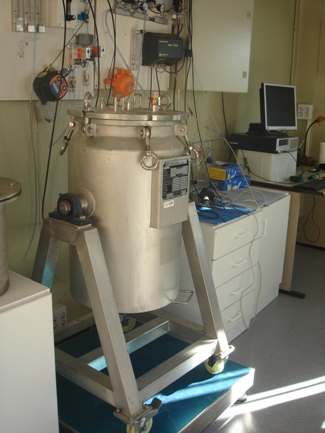Study of Gaseous Emissions from Composting Sludge

The biological treatment of municipal waste water generates large amounts of waste sludge. This sludge, also known as biosolids, is rich inorganic matter, nitrogen, phosphorus, calcium, magnesium, sulfur and other elements. Due to its composition sludge can be valorized through composting. The composting process allows the stabilization of the biodegradable organic matter contained in the waste to obtain an end product, known as compost, which can be applied to the soil as organic amendment. For a good development of the composting process it is important to maintain adequate conditions (humidity, porosity, oxygen concentration, pH, etc.) that ensure the growth and activity of the microbial population responsible for the biological degradation of organic matter. However, it has to be noted that the sludge can also contain toxic compounds such as heavy metals and pesticides that could hinder compost final application.
One of the mainproblems of an industrial-scale composting installation is social opposition often related to odorous pollution. Odors emitted in composting plants are mainly associated to the release of volatile organic compounds (VOC), such as terpenes, alcohols, ketones, amines and sulfur compounds as well as ammonia (NH3). In addition, also methane (CH4) and nitrous oxide (N2O) are emittedduring the composting process. These compounds are greenhouse gases that contribute to the global environmental impact of the facility.
The aimof this work was to study the emissions of VOC, NH3, CH4 and N2O during the composting process of raw and anaerobically digested sludge produced in municipal waste water treatment plants. Firstly, emission factors for the studied compounds were determined. Emission factors represent the amount of compound emitted per unit of waste treated (eg. grams of VOC emissions per ton of treated sludge) allowing the comparison among different waste composting technologies or processes performed at different scales. Following, the main VOC families and compounds present in VOC emission were identified and quantified. These data can be also used in environmental impact studies, for example, in the context of Life Cycle Analysis.
Two types ofsludge were composted at pilot scale in duplicate (50 liters reactors) mixed with shredded pallets, that act as bulking agent. The bulking agent accomplishes two functions in the composting process: the regulation of humidity (sludge has a high content of water not suitable for a good development of the biological activity) and porosity that is essential for the correct supply of the oxygen necessary for the process. Additionally, an innovative process control strategy has been applied. This strategy was developed by the research group allowing maximizing the biological activity in the process, reducing at the same time, the energy required for aeration. Target compounds in gaseous emissions were determined by gas chromatography and mass spectrometry.
Figure 1: Raw sludge and shredded pallet (bulking agent) before being mixed in an adequate ratio for the composting treatment.
The results show higher emission factors in the digested sludge composting process for methane and nitrous oxide than in the case of raw sludge, while those for VOC and ammonia show inverse results (data are summarized the table below). In all cases, terpenes were the dominant VOC family throughout all the processes. Moreover, the evolution of the emissions show that these occur mostly within the first eight days of the treatment process.
Emission factors during sludge composting (kg of emitted compound per t of sludge composted)
| Type of sludge | COV | CH4 | N2O | NH3 |
| Raw sludge | 0.175 | 0.013 | 0.005 | 0.576 |
| Anaerobically digested sludge | 0.033 | 0.780 | 0.525 | 0.004 |
The results of this work can be useful in the design and operation of gaseous emissions treatment equipment in composting plants. Moreover, they can also be worthy in LCA studies and contribute to a better understanding of the gaseous pollutants present in waste composting facilities.
Top left figure: Pilot scale composting reactor (50 liters) used in the experiments.
Adriana Artola
Xavier Font
Antoni Sánchez
Grup d’investigació en compostatge (GICOM)
References
Maulini-Duran, Caterina; Artola, Adriana; Font, Xavier; Sánchez, Antoni. A systematic study of the gaseous emissions from biosolids composting: Raw sludge versus anaerobically digested sludge. Bioresource Technology 147: 43–51. 2013. doi: 10.1016/j.biortech.2013.07.118.


